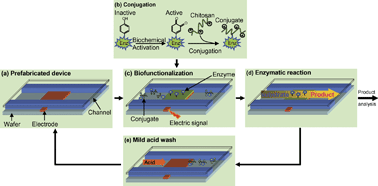Programmable assembly of a metabolic pathway enzyme in a pre-packaged reusable bioMEMS device†
Abstract
We report a biofunctionalization strategy for the assembly of catalytically active enzymes within a completely packaged bioMEMS device, through the programmed generation of electrical signals at spatially and temporally defined sites. The enzyme of a bacterial metabolic pathway, S-adenosylhomocysteine nucleosidase (Pfs), is genetically fused with a pentatyrosine “pro-tag” at its C-terminus. Signal responsive


 Please wait while we load your content...
Please wait while we load your content...